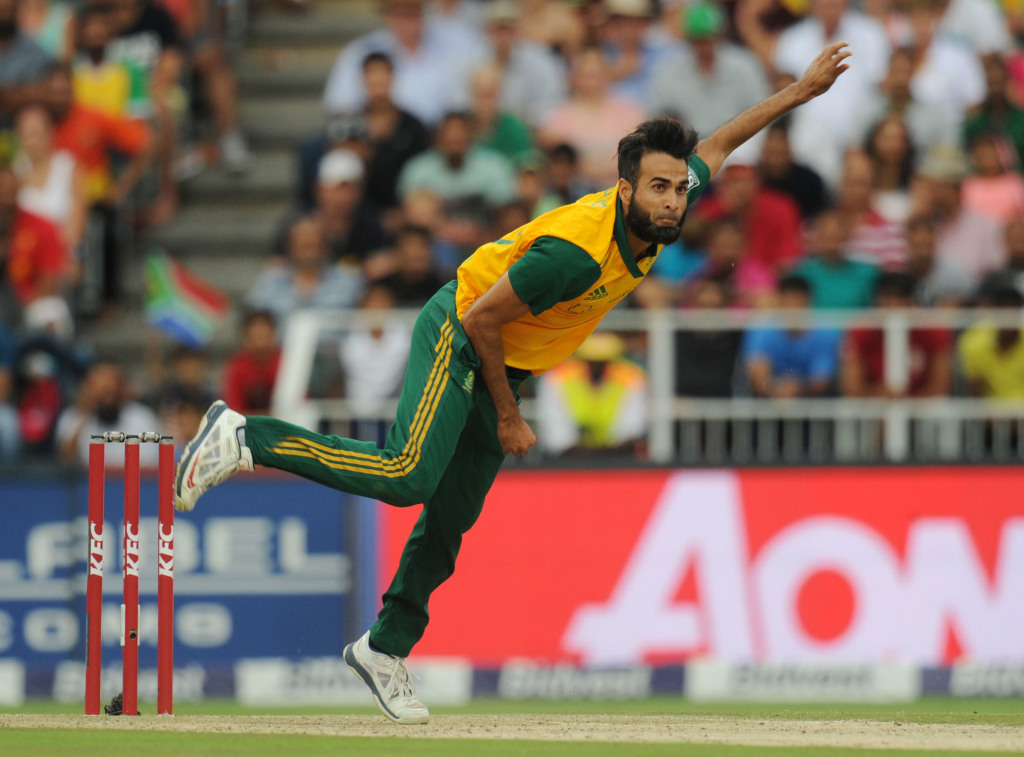Imran Tahir will have a big role to play in the upcoming Cricket World Cup, writes RYAN VREDE.
The Proteas have the fast bowling to elicit the maximum return from Australia’s spicy tracks. The same men have shown their capacity to do similar damage on New Zealand’s more placid surfaces. They are there. Whether the execution of their skill can be consistently applied under pressure throughout the World Cup is the critical question.
But even in conditions that will see the ball fizz and zip more than bite and rip, purveyors of spin will play a defining role in their teams’ fortunes. Perhaps the defining role.
Step up Imran Tahir.
There’s perception and fact when it comes to Tahir in an ODI context. A widely held perception is that he gets carted around the park to the detriment of the team. This is nonsense. Having played 27 ODIs he has a better average (21.17) than the world’s best and second best ODI bowlers, Saeed Ajmal (22.18) and Sunil Narine (26.49), as well as an economy rate that stands up well in comparison. Granted, he has played less matches than Ajmal, but the Pakistani has also played far more matches on turning wickets on the subcontinent than Tahir has. Also remember that very few wrist-spinners in the game’s history have been able to exercise the same level of control that finger spinners do.
Where the two in question edge Tahir is in the match-winning potential they’ve exhibited, with Tahir never once collecting a five-for and only twice achieving a four wicket haul. Still,
the point has to be made that while his value in white is in question, he remains a formidable opponent in green and gold.
Against this background we can then make objective assessments of his value to the Proteas and informed forecasts of how Tahir could fare Down Under.
But while his overall record looks solid enough, it must be tempered by the perspective that the Proteas’ lead spin bowler, Tahir, is a soon-to-be 37-year-old man who did only moderately well in November’s tour of Australia, where two of the Proteas’ three biggest World Cup pool phase matches (India and West Indies) will be played.
Twenty-nine of his 47 ODI wickets have come on the subcontinent, which is not to say he cannot be effective in spin-unfriendly conditions, only that his threat is clearly greatly diminished.
Which, of course, leaves us only with hope that somehow Tahir will find a level of performance and consistency that will amplify the Proteas’ bowling threat at the World Cup. It is critical he does.
At his best Tahir is a world-class operator whose repertoire of deliveries can flummox and bamboozle even the game’s elite. When down on confidence he second-guesses himself, loses tactical patience, shows his entire attacking arsenal in the space of a handful of deliveries and undermines the team’s cause.
We really shouldn’t be concerned in this manner at this stage. He should have been further into his development in terms of his adaptability. After all, Tahir earned his ODI debut four years ago at the World Cup to much fanfare and anticipation. The Proteas believed deeply that he would be their trump card, and he duly delivered – returning figures of 4-38 in 8.4 overs to reduce England to 171 in their pool-phase clash, and then an invaluable 2-32 in nine overs against New Zealand in the quarter-final – both efforts undone by spectacular batting collapses. Still, Tahir emerged as one of the few with his reputation enhanced.
Since then the Proteas would have expected him to have racked up more impressive numbers than he has. Indeed, post World Cup 2011, the South African cricket fraternity had good reason to think that, finally, the Proteas had in their lineup a revolutionist who could dominate ODI cricket. Yet his potency has been restricted to tracks that quickly succumb to spinners’ spells, while he continues to float between fairly solid restrictor or targeted deliverer on decks that don’t bow to his ball’s will.
However, just because he hasn’t ascended to rule ODI cricket in the way many, including this writer, thought he would, Tahir remains a critical inclusion if the Proteas are to hold any real hope of breaking their World Cup title duck. Elsewhere in this magazine former India World Cup-winning coach, now Proteas’ consultant, Gary Kirsten, supports that assertion, even floating the idea of using spin in the death overs – a chronic bowling deficiency – and if so, Tahir is the most likely of the spinners to get the gig.
How he responds to the pressure of a World Cup in which he’ll find the conditions to be wholly less suited to his bowling than the previous one was, remains to be seen. Tahir has fallen to pieces when effectively attacked in Test cricket, and will have to have a strong rebuttal if the same happens at the global showpiece. How and when skipper AB de Villiers uses him will also determine his impact. If the pacemen take tap, Tahir will be
required to operate with a relatively new ball, otherwise he is likely to be deployed in the match-shaping middle overs and perhaps, if he is burning white hot, towards the death like Kirsten intimated.
He may not have become the ODI titan we wanted him to be, but Tahir is the best we’ve got. Now the stage is set for him to give us the best he can.
Tahir at the 2011 World Cup
Matches 5
Wkts 14
BBI 4-38
Bowling ave 10.71
This feature appears in the current issue of SA Cricket magazine, on sale now







